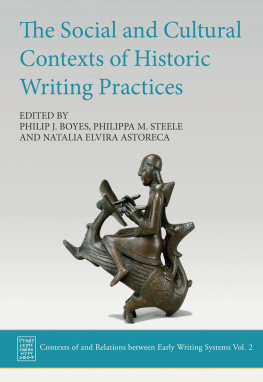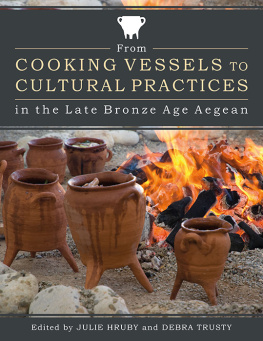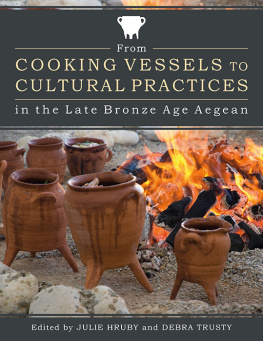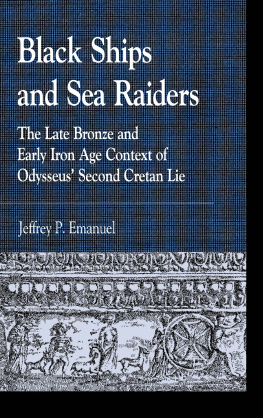Published in the United Kingdom in 2021 by
OXBOW BOOKS
The Old Music Hall, 106108 Cowley Road, Oxford OX4 1JE
and in the United States by
OXBOW BOOKS
1950 Lawrence Road, Havertown, PA 19083
Oxbow Books and the author 2021
Hardback Edition: ISBN 978-1-78925-583-6
Digital Edition: ISBN 978-1-78925-584-3 (ePub)
Kindle Edition: ISBN 978-1-78925-585-0 (Mobi)
A CIP record for this book is available from the British Library
Library of Congress Control Number: 2020952173
An open-access on-line version of this book is available at: http://books.casematepublishing.com/ Script_and_Society. The online work is licensed under the Creative Commons Attribution 3.0 Unported Licence. To view a copy of this license, visit http://creativecommons.org/licenses/ by/3.0/ or send a letter to Creative Commons, 444 Castro Street, Suite 900, Mountain View, California, 94041, USA. This licence allows for copying any part of the online work for personal and commercial use, providing author attribution is clearly stated.
Some rights reserved. No part of the print edition of the book may be reproduced or transmitted in any form or by any means, electronic or mechanical including photocopying, recording or by any information storage and retrieval system, without permission from the publisher in writing.
Materials provided by third parties remain the copyright of their owners.
For a complete list of Oxbow titles, please contact:
| UNITED KINGDOM | UNITED STATES OF AMERICA |
| Oxbow Books | Oxbow Books |
| Telephone (01865) 241249 | Telephone (610) 853-9131, Fax (610) 853-9146 |
| Email: | Email: |
| www.oxbowbooks.com | www.casemateacademic.com/oxbow |
Oxbow Books is part of the Casemate Group
Cover illustration by Philip Boyes. Stele from Ugarit showing treaty-signing with possible writing-boards.
Acknowledgements
No research project is the work of a single person in isolation, and this book in particular has benefited from the support and assistance of a great many people. It was written between 2016 and 2020 under the aegis of the CREWS Project Contexts of and Relations between Early Writing Systems, based at the Faculty of Classics, University of Cambridge and funded by the European Research Council under the European Unions Horizon 2020 research and innovation programme (grant agreement No 677758). This has, of course, been a time of great trauma and upheaval for the United Kingdoms relationship with Europe, and I am profoundly grateful to the European Union for all it has done, and continues to do, to support research such as this. I hope that Britains self-imposed exile from this hugely beneficial combined effort will be a short one.
The CREWS Project has consisted of five members: Philippa Steele, the principal investigator, Robert Crellin, Natalia Elvira Astoreca, our administrator Sarah Lewis, and myself. The research in this volume has been massively enriched by the ideas and practical support these colleagues have offered, but I must single out Philippa for particular thanks. The best project leader anyone could hope for, she has offered constant advice, feedback and support over the last four years, including reading and commenting on multiple drafts of the manuscript.
Beyond CREWS, I must thank a number of other colleagues at Cambridge, in particular Martin Worthington, Selena Wisnom and Marie-Franoise Besnier, who all went above and beyond the call of duty in allowing me to join their Akkadian classes. Without them, my understanding of Semitic scripts and languages and of Mesopotamian culture would be very much poorer. Augusta McMahon served as my mentor in postdoctoral research and has also given helpful thoughts and advice. I must also thank Nicholas Postgate for many helpful comments on my research at seminars and conference presentations, and for very generously giving me his volumes of Le Palais royal dUgarit . My friends and colleagues at the Faculty of Classics, Annie Burman, Anna Judson, Matthew Scarborough and Daniel Unruh, have all been great sources of advice and support on research and navigating a postdoctoral career. I would also like to thank the Universitys support staff especially the librarians, computer officers and open access advisers who have done a great deal to facilitate my work and its dissemination. The non-academic staff at universities rarely get the credit and appreciation they deserve, and I am very grateful to them.
Several fellow scholars have allowed me to reuse their images or offered thoughts, questions or suggestions when I have presented my research which have shaped my subsequent thinking. Where appropriate, these are acknowledged in the text. Others have sent me articles, pointed me in the direction of references or answered questions I had. Sophie Hardach helped me with some German.
Two reviewers read and commented on a draft manuscript of this work. Their suggestions were extremely constructive and helpful, and I am extremely grateful for their time and advice.
A draft version of this volume was largely completed by spring 2020, but the process of review and revision coincided with the coronavirus pandemic that took hold early in that year. I was fortunate to have completed the bulk of the research before the effects of this crisis became severe, but even so, there has been an impact. It hasnt always been possible to chase up references or contact people or organisations for image permissions. This is not to blame the virus for any mistakes or deficiencies in what is presented here, but to admit openly that there are things I would have liked to have included or elaborated in the later stages of revision which I have not been able to.
Finally, my deepest thanks and love to my wife Jennie, for everything she does.

Fig. 0.1. Map of the city of Ugarit. Redrawn by the author after Saad (2011, fig. 46).

Fig. 0.2. Map of the Kingdom of Ugarit. Drawn by the author after Calvet (2012, fig. 1).
















